Book contents
- Frontmatter
- Contents
- List of figures
- List of tables
- List of contributors
- Preface
- Acknowledgments
- 1 The social construction of literacy
- 2 Literacy and schooling: an unchanging equation?
- 3 Interactional sociolinguistics in the study of schooling
- 4 The language experience of children at home and at school
- 5 Narrative presentations: an oral preparation for literacy with first graders
- 6 Differential instruction in reading groups
- 7 Organizational constraints on reading group mobility
- 8 Developing mathematical literacy in a bilingual classroom
- 9 Spoken language strategies and reading acquisition
- 10 Speaking and writing: discourse strategies and the acquisition of literacy
- 11 The implicit discourse genres of standardized testing: what verbal analogy items require of test takers
- References
- Author index
- Subject index
9 - Spoken language strategies and reading acquisition
Published online by Cambridge University Press: 05 June 2012
- Frontmatter
- Contents
- List of figures
- List of tables
- List of contributors
- Preface
- Acknowledgments
- 1 The social construction of literacy
- 2 Literacy and schooling: an unchanging equation?
- 3 Interactional sociolinguistics in the study of schooling
- 4 The language experience of children at home and at school
- 5 Narrative presentations: an oral preparation for literacy with first graders
- 6 Differential instruction in reading groups
- 7 Organizational constraints on reading group mobility
- 8 Developing mathematical literacy in a bilingual classroom
- 9 Spoken language strategies and reading acquisition
- 10 Speaking and writing: discourse strategies and the acquisition of literacy
- 11 The implicit discourse genres of standardized testing: what verbal analogy items require of test takers
- References
- Author index
- Subject index
Summary
Example 9.1
child 1
It looks like a music note … but it has points and it sort of looks like a saucer.
child 2
This one just looks like a … something right here, like this part right here, look like a key. And this right here … looks like a planet … like a ship.
Both of these children are describing an abstract figure in the presence of an adult. They have been told that their description, which is being tape‐recorded, will be heard by one of their classmates, who will have to pick out the figure they are describing from an array of nine abstract figures. Although these descriptions were equally successful in accomplishing the task, they have a number of differences. One of these differences concerns the degree to which they are tied to the temporal and physical situation in which they are produced. The first description is appropriate for written communication, but the other is not.
Communication in oral and written language is different in multiple ways (Rubin 1978; Schallert, Kleiman and Rubin 1977). Speech tends to be multi‐channeled, including lexical–semantic–syntactic, interactional, paralinguistic and nonverbal modes of transmission, while writing is most often unimodal, depending heavily on the lexical–semantic–syntactic channel. Early formulations of oral and written language characterized oral language as having a high degree of interaction and involvement of participants who share the same temporal and spatial context, often in face‐to‐face encounters.
- Type
- Chapter
- Information
- The Social Construction of Literacy , pp. 218 - 244Publisher: Cambridge University PressPrint publication year: 2006
- 1
- Cited by

